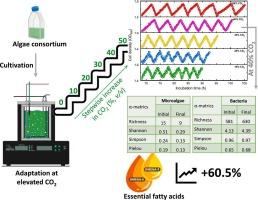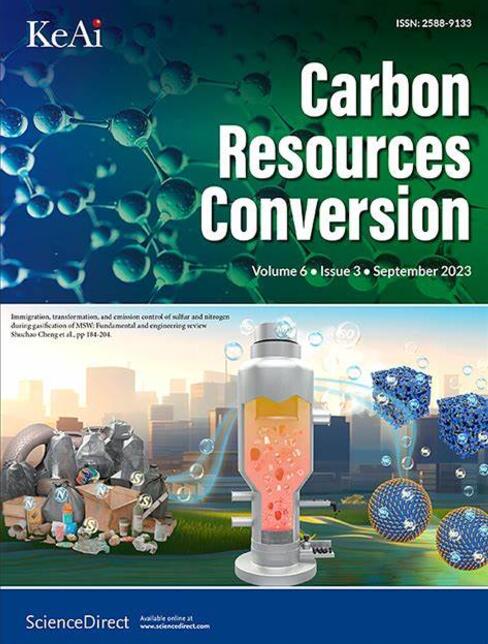Progressive adaptation of microalgae consortium to elevated carbon dioxide coupled with enhanced production of essential fatty acids
IF 7.5
3区 环境科学与生态学
Q2 ENERGY & FUELS
引用次数: 0
Abstract
This study investigated the possible adaptation of a microalgae consortium to elevated carbon dioxide (CO2) concentrations reaching up to 50 % v/v in a lab-scale photobioreactor (PBR). Results showed a significant reduction in the growth rate of the consortium with increasing CO2 supplementation, from 1.327 d-1 in the initial culture without CO2 supplementation to 0.369 d-1 at 50 % CO2. At the lowest applied CO2 supplementation of 10%, the growth rate was 0.735 d-1. Interestingly, supplementation of 40% CO2 in the final run showed insignificant difference in the growth rate of the consortium compared to that at 10% CO2. Microbial community analysis revealed a shift towards bacterial genera that enhance the microalgal growth, while some algal genera (mainly Tetradesmus and Chlorella) became more dominant under CO2 enrichment. Compared to the initial consortium, the proportion of polyunsaturated fatty acids (PUFAs) increased from 36.2% to 58.1% under 40% CO2, mainly due to the increase in the proportion of essential fatty acids (EFAs) such as alpha-linolenic acid (ALA) and linoleic acid (LA). Under 40% CO2 supplementation, an increase in cell size was observed, despite a reduction in cell number. This study highlights the potential of microalgae consortia to adapt to high CO2 levels, leading to a dominance of certain algal genera. This adaptation improves the production of EFAs, thereby contributing to both environmental sustainability and industrial applications.

微藻联合体对高浓度二氧化碳的逐步适应以及必需脂肪酸的增强生产
本研究探讨了微藻联合体在实验室规模光生物反应器(PBR)中对二氧化碳(CO2)浓度升高达到50% v/v的可能适应性。结果表明,随着CO2添加量的增加,该联合体的生长速率显著降低,从初始培养时不添加CO2的1.327 d-1降至50% CO2时的0.369 d-1。最低CO2添加量为10%时,生长速率为0.735 d-1。有趣的是,在最后一次运行中补充40%的二氧化碳与10%的二氧化碳相比,联合体的生长速度没有显著差异。微生物群落分析显示,在CO2富集条件下,微藻的生长向有利于微藻生长的细菌属转移,而一些藻类属(主要是四角藻和小球藻)则变得更占优势。与初始财团相比,在40% CO2下,多不饱和脂肪酸(PUFAs)的比例从36.2%增加到58.1%,主要是由于必需脂肪酸(EFAs)如α -亚麻酸(ALA)和亚油酸(LA)的比例增加。在补充40%二氧化碳的情况下,观察到细胞大小增加,尽管细胞数量减少。这项研究强调了微藻联合体适应高二氧化碳水平的潜力,导致某些藻类属的优势。这种适应改进了EFAs的生产,从而促进了环境可持续性和工业应用。
本文章由计算机程序翻译,如有差异,请以英文原文为准。
求助全文
约1分钟内获得全文
求助全文
来源期刊

Carbon Resources Conversion
Materials Science-Materials Science (miscellaneous)
CiteScore
9.90
自引率
11.70%
发文量
36
审稿时长
10 weeks
期刊介绍:
Carbon Resources Conversion (CRC) publishes fundamental studies and industrial developments regarding relevant technologies aiming for the clean, efficient, value-added, and low-carbon utilization of carbon-containing resources as fuel for energy and as feedstock for materials or chemicals from, for example, fossil fuels, biomass, syngas, CO2, hydrocarbons, and organic wastes via physical, thermal, chemical, biological, and other technical methods. CRC also publishes scientific and engineering studies on resource characterization and pretreatment, carbon material innovation and production, clean technologies related to carbon resource conversion and utilization, and various process-supporting technologies, including on-line or off-line measurement and monitoring, modeling, simulations focused on safe and efficient process operation and control, and process and equipment optimization.
 求助内容:
求助内容: 应助结果提醒方式:
应助结果提醒方式:


